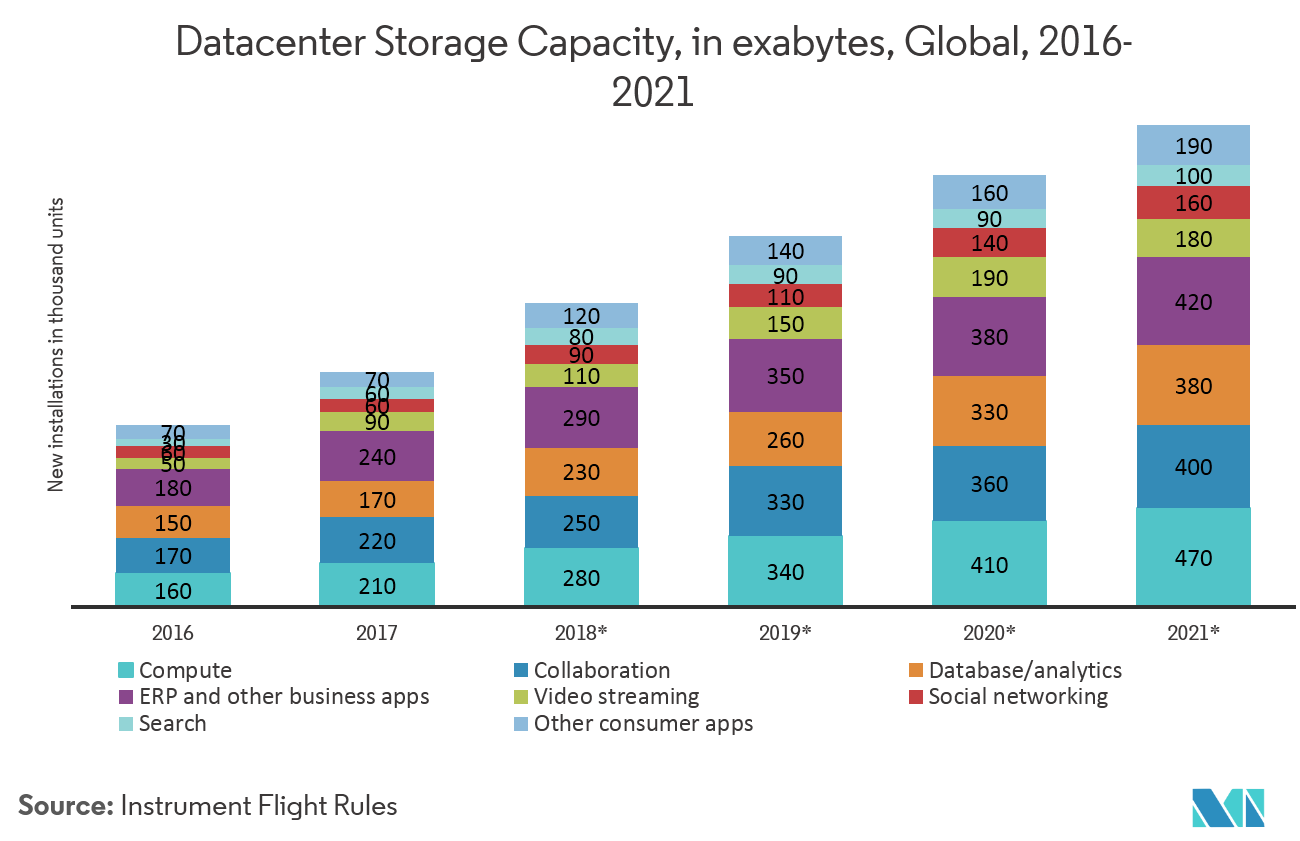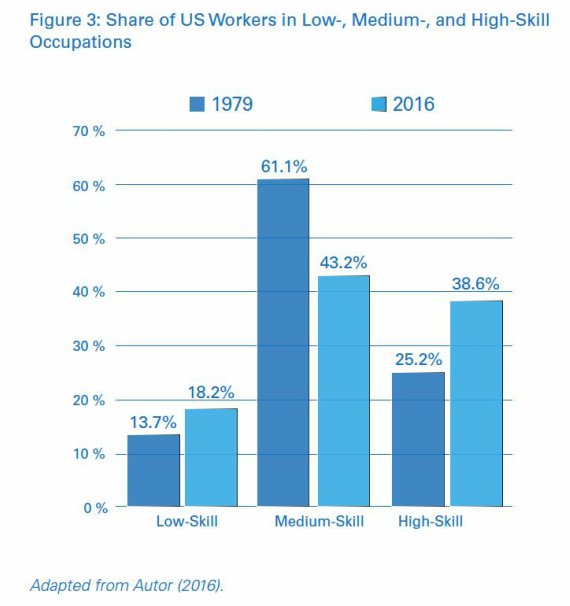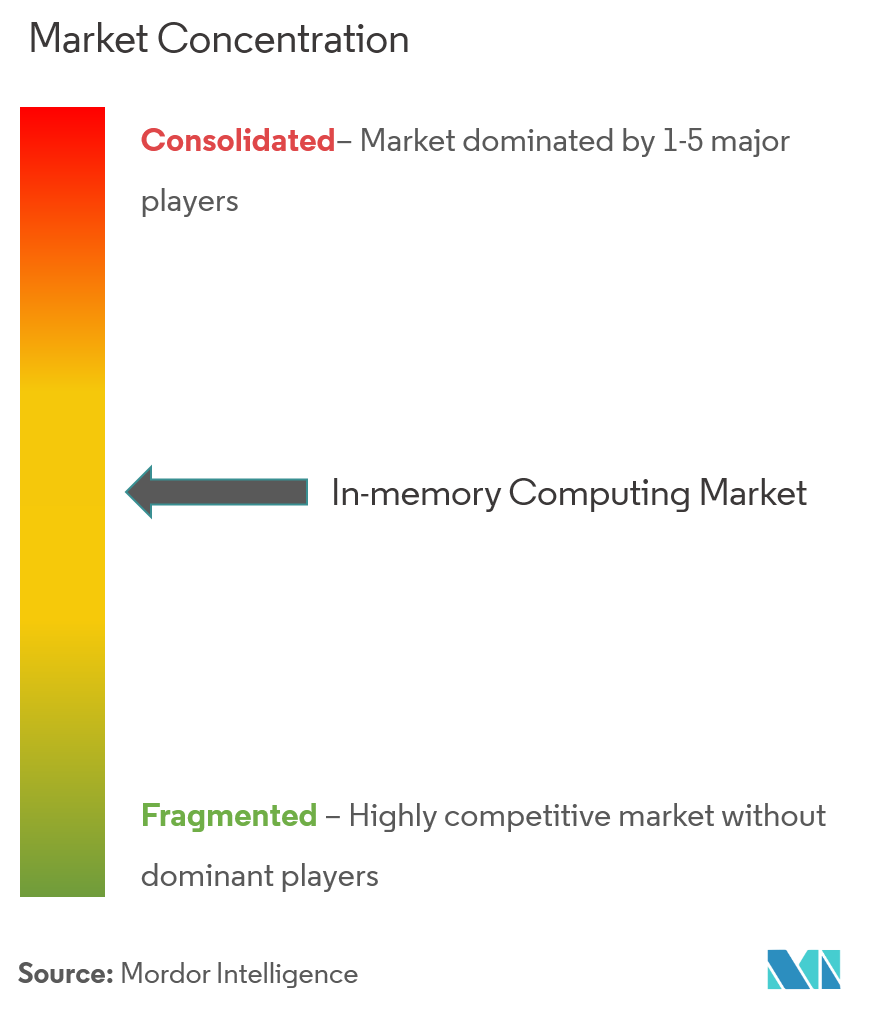MARKET OVERVIEW
n-memory Computing Market is estimated to register a CAGR of 25.37% over the forecast period (2020-2025). Adoption of In-memory Computing, also known as IMC, is on the rise. This can be attributed to the growing demand for faster processing and analytics on big data, the need for simplifying architecture as the number of various data sources increases, and technology enhancements that are optimizing total cost of ownership (TCO).
- To maintain a competitive edge and meet the demands for optimal customer experience in the current scenario, enterprises are seeking for solutions to deal with the constant upsurge of available data and the never-ending demands for better and faster performance. This is boosting the development of In-Memory Computing technologies.
- Over the past several years, companies across a broad range of industries increasingly started adopting in-memory computing platforms to achieve the application performance and scalability they need to achieve their digital transformation or omnichannel customer experience goals.
- For instance, American Airlines is using in-memory computing to accelerate response times, automate processes and meet SLAs for business applications that process huge datasets from multiple sources.
- Further, developments with respect to peer-to-peer transactions, bitcoins and mobile wallets are an addition to the instant payment capabilities. This enables the service providers to ensure a level of reliability and scale capacity ahead of demand. And, in-memory computing platform helps them by offering low latency, scalability and resilience.
- The outbreak of Covid-19 will affect the chip manufacturing industry in the short-term as several operations have come to a halt because of global lockdown. But at the same time, companies are collaborating to find the cure of this pandemic using advance computing, which uses IMC, for analysis. For instance, recently Intel and Lenovo collaborated with the Beijing-based BGI Genomics to apply its technology and expertise, and further accelerate the analysis of genomic characteristics of COVID-19.
Scope of the Report
In-memory computing is the storage of information in the main random access memory (RAM) of dedicated servers rather than in complicated relational databases operating on comparatively slow disk drives. Type of components such as In-memory Data Management and In-memory Applications are considered unde the scope of the report. The In-memory Applications include in-memory analytics and in-memory application server.
| By Component | |
| In-memory Data Management | |
| In-memory Application |
| By End-user Vertical | |
| BFSI | |
| Healthcare | |
| IT & Telecom | |
| Government | |
| Other End-user Verticals |
| Geography | |
| North America | |
| Europe | |
| Asia-Pacific | |
| Latin America | |
| Middle East and Africa |
Key Market Trends
In-memory Data Management to Hold Significant Share
In-memory data management is the process of monitoring and managing the storage retrieval and operations of data stored within a computer, server or other computing device memory.
- In-memory technology has become a relied-upon part of the data world, now available through most major database vendors. In-memory can process workloads up to 100 times faster than disk-to-memory configurations, which enables business at the speed of thought.
- In-memory databases and technologies enable decision makers to get to the information they are seeking rapidly and more readily.
- While in-memory technology has been on the market for many years, currently, the demand for intelligent, interactive experiences requires back-end systems and applications operating at high performance, and incorporating movement and delivery of data faster than ever before.
- According to a recent Unisphere-AWS survey, over the next 3 years, 60% of IT managers, DBAs, and C-level executives expect to store more data in the cloud than on-premise. In addition, the use of NoSQL platforms, including document, graph, columnar, and in-memory, which are still in the relatively early days of adoption, will also see an increase, spurred by new applications for the technology and an increased availability of skills and expertise.

To understand key trends, Download Sample Report
Asia-Pacific to Witness Fastest Growth
- Asia-Pacific is estimated to be the fastest-growing region, owing to the presence of countries, such as China, Japan, and India. These countries act as the hub for enterprises such as BPOs and KPOs, and hence are known as manufacturing factories of the world. The very basic foundation of such organizations is the huge quantities of data that need to be stored, analyzed, and then used for the purpose of decision-making. This indicated the huge growth potential for the IMC market in Asia-Pacific.
- The increased demand for big data and growing number of SME’s offers huge opportunities for growth in this region. Increasing investment by several incumbent technology players are some of the factors driving the market in the APAC region.
- The in-memory computing market is consolidated, with major players, such as SAP SE, Microsoft, Oracle, Altibase, and others. These players adopted various strategies, such as new product developments, in addition to collaborations and partnerships, and business expansions to accommodate the needs of the market. The major market players have adopted acquisitions and integrations as major strategy to expand their market shares, security portfolio, and customer base.

Competitive Landscape
The competitive rivalry in this industry is high and this market is highly fragmented. Market incumbents, such as SAP, SAS, and Oracle Corporation have considerable influence on the overall market. Vendors of in-memory computing are increasingly focusing on delivering enhanced solutions that can cater to various requirements.
- July 2019 - Intel and SAP announced a multi-year technology partnership focused on optimizing Intel’s platforms, including Intel Xeon Scalable processors and Intel Optane DC persistent memory, for end-to-end SAP enterprise software applications, including SAP S/4HANA. The partnership will use technologies from Intel to boost the SAP platform technologies that underpin its enterprise applications, including: real-time in-memory computing, streaming and Big Data analytics, blockchain, augmented and virtual reality, machine learning and artificial intelligence, Internet of Things, and security.
- May 2019 - TIBCO acquired SnappyData, a provider of a Spark-based data platform. The acquisition is estimated to enable data scientists with a high-speed, highly scalable in-memory data store to explore new, larger data sets
JOB POLARIZATION
Low-Skill Jobs
Middle-Skill Jobs
High-Skill Jobs


Great work!! 👍💯
ReplyDeleteThank you!
DeleteGreat Read!! Keep up the good work guys!!
ReplyDeleteThanks
DeleteThis comment has been removed by the author.
ReplyDeleteThis comment has been removed by the author.
ReplyDeleteHighly informative
ReplyDeleteNice!!
ReplyDeleteThank you!
Deletenice written ! very informative
ReplyDeleteThanks
DeleteAmazing
ReplyDeleteThank you
DeleteGood research! Keep going
ReplyDeleteThank you so much
DeleteAwesome work!! Very clear and simplified!
ReplyDeleteThank you!
DeleteAwesome work!! Very clear and simplified!👍
ReplyDeleteVery informative��������
ReplyDeleteThank you
DeleteVery well explained 👍
ReplyDeleteVery well explained
ReplyDeleteKeep it up
Nice Explaination !
ReplyDeleteVery well explained
ReplyDeleteVery informative
ReplyDeleteGreat Insight!!!
ReplyDeleteGreat bro
ReplyDeleteGuys good work
ReplyDeleteVery informative really appreciated one
ReplyDelete